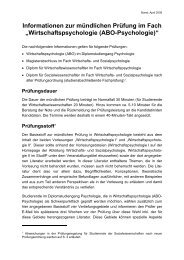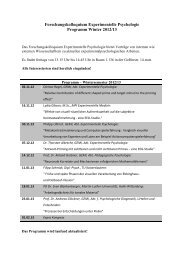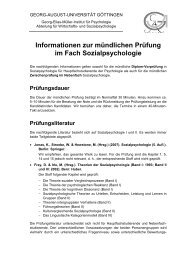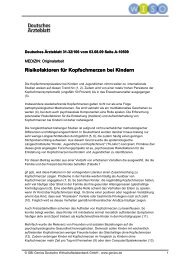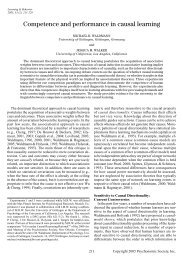Pretence as Individual and Collective Intentionality
Pretence as Individual and Collective Intentionality
Pretence as Individual and Collective Intentionality
You also want an ePaper? Increase the reach of your titles
YUMPU automatically turns print PDFs into web optimized ePapers that Google loves.
512<br />
H. Rakoczy<br />
here than in the c<strong>as</strong>e of serious institutional phenomena. No recourse to a web of<br />
related practices is needed. What makes the context right is only a matter of the<br />
agreement of the other participants. This is the sense in which pretending is a form<br />
of fi ctional world-making. And on the model of such fi ctional world-making<br />
children might come to underst<strong>and</strong> fact-making in more serious institutional<br />
are<strong>as</strong>.<br />
3. Conclusion<br />
Early child pretend play is a remarkable instance of advanced forms of individual<br />
<strong>and</strong> collective intentionality. In interpreting others ’ pretence behaviours, young<br />
children reveal some relatively sophisticated second-order intentionality. In contr<strong>as</strong>t<br />
to lean interpretations of the child ’ s underst<strong>and</strong>ing of pretence (e.g. Lillard, 1998;<br />
Nichols <strong>and</strong> Stich, 2000 ), young pretenders do not just see pretending <strong>as</strong> a form of<br />
deviant (<strong>as</strong>-if) behaviour . Rather, they see pretence <strong>as</strong> a specifi c form of intentional<br />
action . They gr<strong>as</strong>p the b<strong>as</strong>ic intentional structure of pretending in contr<strong>as</strong>t to other<br />
forms of superfi cially analogous <strong>as</strong>-if-behaviours (e.g. failed attempts) which enables<br />
them to respond fl exibly, creatively <strong>and</strong> inferentially appropriately to others ’<br />
pretence acts. However, in contr<strong>as</strong>t to strongly modular, nativist <strong>and</strong> conceptatomistic<br />
accounts ( Leslie, 1987, 1994 ), this does not necessarily warrant <strong>as</strong>cribing<br />
m<strong>as</strong>tery of the full-fl edged adult concept ‘ pretend ’ to 2-year-olds. Rather, on a<br />
moderately holistic view of concept-possession, the young pretender can be seen<br />
<strong>as</strong> m<strong>as</strong>tering some though not all inferential connections central to our adult<br />
concept of pretending (much like the young folk psychologist generally who<br />
m<strong>as</strong>ters some but not all inferential moves central to our concept of ‘ intention ’ , for<br />
example). Coming to underst<strong>and</strong> pretending is a gradual affair of conceptual<br />
change.<br />
That leaves us with two central questions for future research in this area. First,<br />
how exactly do children move from an early underst<strong>and</strong>ing of pretending <strong>as</strong> a<br />
specifi c form of non-serious intentional activity (from the time they pretend) to<br />
our mature adult underst<strong>and</strong>ing? How exactly do they come to m<strong>as</strong>ter new<br />
inferential relations between, for example, pretending, believing, deceiving etc.?<br />
And second, how do children come to underst<strong>and</strong> <strong>and</strong> acquire pretence <strong>as</strong> a<br />
specifi c form of intentional activity in the fi rst place? Quite likely, pretence grows<br />
out of simpler forms of action. Pretend play is a non-serious, non-instrumental<br />
form of intentional action done for its own sake. In coming to underst<strong>and</strong> <strong>and</strong><br />
acquire pretending, children probably build on their underst<strong>and</strong>ing of intentional<br />
action, <strong>and</strong> of non-serious <strong>and</strong> non-instrumental forms of action in particular<br />
which develop some months before the ontogenetic emergence of pretend play.<br />
From around one year of age, children reveal some b<strong>as</strong>ic underst<strong>and</strong>ing of<br />
intentional action (<strong>as</strong> indicated, in particular, in their imitation; see Tom<strong>as</strong>ello <strong>and</strong><br />
Carpenter, 2005 ), <strong>and</strong> of simple ‘ non-serious ’ acts such <strong>as</strong> te<strong>as</strong>ing ( Behne,<br />
Carpenter, Call <strong>and</strong> Tom<strong>as</strong>ello, 2005; Reddy, 1991 ). And from 14 months infants<br />
© 2008 The Author<br />
Journal compilation © 2008 Blackwell Publishing Ltd





